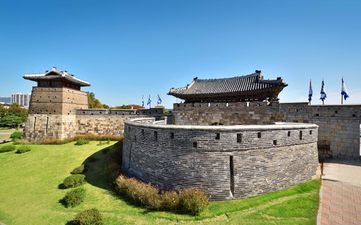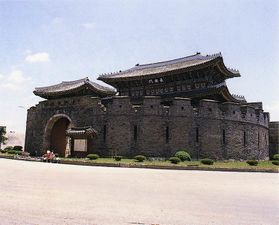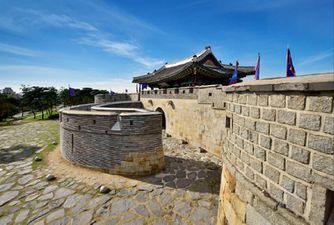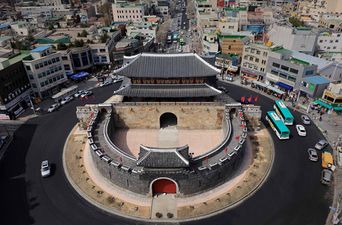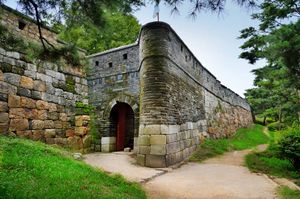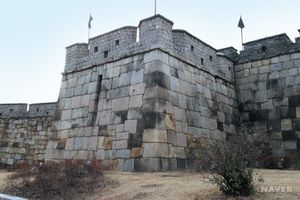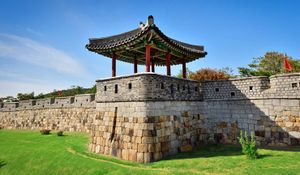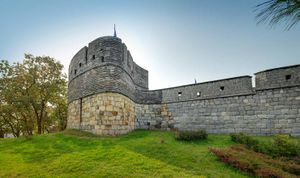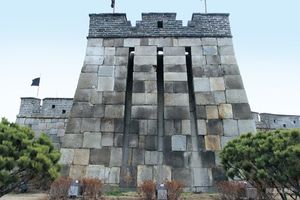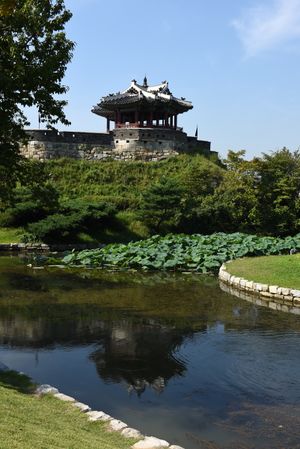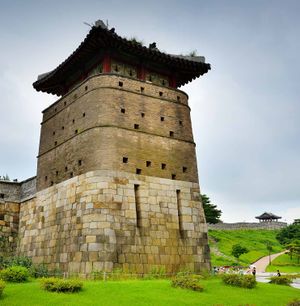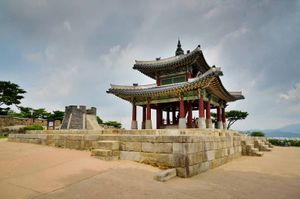수원 화성 성곽 구조
목차
- 1 성곽 구조 및 영문 명칭
- 1.1 성문(城門) : Gate
- 1.2 암문(暗門) : Secret Entrance
- 1.3 수문(水門) : Watergate
- 1.4 치(雉) : Bastion
- 1.5 포루(舖樓) : Guard Pavilion
- 1.6 포루(砲樓) : Artillery Pavilion
- 1.7 노대(弩臺) : Archery Platform
- 1.8 적대(敵臺) : Gate Guard Post
- 1.9 각루(角樓) : Corner Pavilion
- 1.10 공심돈(空心墩) : Watchtower
- 1.11 용도(甬道) : Extended Wall
- 1.12 장대(將臺) : Command Post
- 1.13 봉수대 : Beacon Tower
- 2 주석
성곽 구조 및 영문 명칭
성문(城門) : Gate
| 국문 명칭 | 한자 표기 | 공식 영문 명칭 제안 | 약칭(지명 생략) |
|---|---|---|---|
| 화서문[1] | 華西門 | Hwaseomun Gate, Suwon | Hwaseomun Gate |
| 장안문 | 長安門 | Janganmun Gate, Suwon | Janganmun Gate |
| 창룡문 | 蒼龍門 | Changnyongmun Gate, Suwon | Changnyongmun Gate |
| 팔달문[2] | 八達門 | Paldalmun Gate, Suwon | Paldalmun Gate |
- 화성의 4대문
암문(暗門) : Secret Entrance
눈에 잘 띄지 않는 은밀한 곳에 내는 작은 성문의 하나.
눈에 띄면 안 되기 때문에 개구부 위에 문루를 세우지 않으며 외부에서 식별할 수 있는 어떠한 시설도 하지 않는다. 전쟁시 적의 눈에 띄지 않고 성내에서 필요한 병기나 식량 등을 운반하는 비밀통로 역할을 하였다.
수원 화성은 벽돌로 쌓은 홍예식 암문이 많다.[3]
| 국문 명칭 | 한자 표기 | 공식 영문 명칭 제안 | 약칭(지명 생략) |
|---|---|---|---|
| 서암문 | 西暗門 | Western Secret Entrance of Hwaseong Fortress, Suwon | Western Secret Entrance |
| 서남암문과 서남포사 | 西南暗門과 西南舖舍 | Southwestern Secret Entrance and Guard Pavilion of Hwaseong Fortress, Suwon | Southwestern Secret Entrance and Guard Pavilion |
| 동암문 | 東暗門 | Eastern Secret Entrance of Hwaseong Fortress, Suwon | Eastern Secret Entrance |
| 북암문 | 北暗門 | Northern Secret Entrance of Hwaseong Fortress, Suwon | Northern Secret Entrance |
수문(水門) : Watergate

모든 성곽에는 배수를 위한 시설이 있는데 규모가 크고 문형식을 갖춘 것을 수문(水門)이라고 하고 배수구만 뚫어 놓은 것을 수구(水口)라고 한다. 성 안에서 발생하는 모든 물을 배출하는 역할을 하며 수량이 많거나 성 안에 내가 흐르는 경우는 교량과 같이 연속홍예를 틀어 만들기도 한다.
수문에는 적의 침투를 막고자 방어시설을 하는데 화홍문의 경우 철로 만든 살문을 달아 다리 위에서 유사시에 여닫을 수 있도록 했다.[5]
| 국문 명칭 | 한자 표기 | 공식 영문 명칭 제안 | 약칭(지명 생략) |
|---|---|---|---|
| 북수문(화홍문) | 北水門(華虹門) | Hwahongmun Watergate of Hwaseong Fortress, Suwon | Hwahongmun Watergate (Northern Watergate) |
| 남수문 | 南水門 | Southern Watergate of Hwaseong Fortress, Suwon | Southern Watergate |
치(雉) : Bastion
성벽 일부를 돌출시켜 적의 접근을 조기에 관찰하고 성벽에 접근한 적을 정면이나 측면에서 공격할 수 있는 시설물.[6]
| 국문 명칭 | 한자 표기 | 공식 영문 명칭 제안 | 약칭(지명 생략) |
|---|---|---|---|
| 서1치 | 西一雉 | Western Bastion I of Hwaseong Fortress, Suwon | Western Bastion I |
| 서2치 | 西二雉 | Western Bastion II of Hwaseong Fortress, Suwon | Western Bastion II |
| 서3치 | 西三雉 | Western Bastion III of Hwaseong Fortress, Suwon | Western Bastion III |
| 남치 | 南雉 | Southern Bastion of Hwaseong Fortress, Suwon | Southern Bastion |
| 동1치 | 東一雉 | Eastern Bastion I of Hwaseong Fortress, Suwon | Eastern Bastion I |
| 동2치 | 東二雉 | Eastern Bastion II of Hwaseong Fortress, Suwon | Eastern Bastion II |
| 동3치 | 東三雉 | Eastern Bastion III of Hwaseong Fortress, Suwon | Eastern Bastion III |
| 북동치 | 北東雉 | Northeastern Bastion of Hwaseong Fortress, Suwon | Northeastern Bastion |
포루(舖樓) : Guard Pavilion
치(雉) 위에 누각을 두는 경우. 포사(舖舍)라고도 함. [7]
| 국문 명칭 | 한자 표기 | 공식 영문 명칭 제안 | 약칭(지명 생략) |
|---|---|---|---|
| 북포루 | 北舖樓 | Northern Guard Pavilion of Hwaseong Fortress, Suwon | Northern Guard Pavilion |
| 서포루 | 西舖樓 | Western Guard Pavilion of Hwaseong Fortress, Suwon | Western Guard Pavilion |
| 동일포루 | 東一舖樓 | Eastern Guard Pavilion I of Hwaseong Fortress, Suwon | Eastern Guard Pavilion I |
| 동이포루 | 東二舖樓 | Eastern Guard Pavilion II of Hwaseong Fortress, Suwon | Eastern Guard Pavilion II |
| 동북포루 | 東北舖樓 | Northeastern Guard Pavilion of Hwaseong Fortress, Suwon | Northeastern Guard Pavilion |
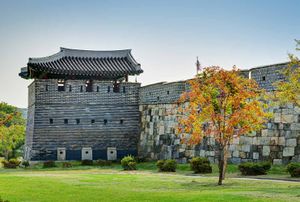
포루(砲樓) : Artillery Pavilion
포사나 포루(舖樓)에 포(砲)를 설치한 경우. [9]
| 국문 명칭 | 한자 표기 | 공식 영문 명칭 제안 | 약칭(지명 생략) |
|---|---|---|---|
| 북서포루 | 北西砲樓 | Northwestern Artillery Pavilion of Hwaseong Fortress, Suwon | Northwestern Artillery Pavilion |
| 서포루 | 西砲樓 | Western Artillery Pavilion of Hwaseong Fortress, Suwon | Western Artillery Pavilion |
| 남포루 | 南砲樓 | Southern Artillery Pavilion of Hwaseong Fortress, Suwon | Southern Artillery Pavilion |
| 동포루 | 東砲樓 | Eastern Artillery Pavilion of Hwaseong Fortress, Suwon | Eastern Artillery Pavilion |
| 북동포루 | 北東砲樓 | Northeastern Artillery Pavilion of Hwaseong Fortress, Suwon | Northeastern Artillery Pavilion |
노대(弩臺) : Archery Platform
누각은 없지만 연속으로 화살을 쏠 수 있는 무기인 노수(弩手)가 배치된 치(雉).
화성의 서장대에는 치 형식이 아닌 독립된 팔각형의 노대도 있다.[10]
| 국문 명칭 | 한자 표기 | 공식 영문 명칭 제안 | 약칭(지명 생략) |
|---|---|---|---|
| 서노대 | 西弩臺 | Western Archery Platform of Hwaseong Fortress, Suwon | Western Archery Platform |
| 동북노대 | 東北弩臺 | Northeastern Archery Platform of Hwaseong Fortress, Suwon | Northeastern Archery Platform |
적대(敵臺) : Gate Guard Post
성문 좌우에 설치하는 치(雉)를 체성(体城)에 설치하는 치와 특별히 구분하여 적대(敵臺)라고 불렀다.
성문을 보호하기 위한 시설로 측면에서 공격할 수 있도록 만든 공격시설이다.[11]
| 국문 명칭 | 한자 표기 | 공식 영문 명칭 제안 | 약칭(지명 생략) |
|---|---|---|---|
| 북동적대 | 北東敵臺 | Northeastern Gate Guard Post of Hwaseong Fortress, Suwon | Northeastern Gate Guard Post |
| 북서적대 | 北西敵臺 | Northwestern Gate Guard Post of Hwaseong Fortress, Suwon | Northwestern Gate Guard Post |
각루(角樓) : Corner Pavilion
성벽 모서리에 설치된 치.
각루는 성벽 전체를 조망할 수 있고 멀리까지 적의 동태를 살필 수 있도록 높게 설치한다.[12]
수원 화성의 네 개의 각루 중 동북각루는 방화수류정이라고 부르며, 보물 제1709호로 지정되어 있다.
| 국문 명칭 | 한자 표기 | 공식 영문 명칭 제안 | 약칭(지명 생략) |
|---|---|---|---|
| 서북각루 | 西北角樓 | Northwestern Corner Pavilion of Hwaseong Fortress, Suwon | Northwestern Corner Pavilion |
| 서남각루 | 西南角樓 | Southwestern Corner Pavilion of Hwaseong Fortress, Suwon | Southwestern Corner Pavilion |
| 동남각루 | 東南角樓 | Southeastern Corner Pavilion of Hwaseong Fortress, Suwon | Southeastern Corner Pavilion |
| 방화수류정 | 訪花隨柳亭 | Northeastern Corner Pavilion of Hwaseong Fortress, Suwon (Banghwasuryujeong Pavilion, Suwon) | Northeastern Corner Pavilion (Banghwasuryujeong Pavilion) |
공심돈(空心墩) : Watchtower
수원 화성에서는 누각 아래를 벽돌로 높이 쌓고 실내는 비어있으며 벽에는 계단을 따라 총혈이나 포혈을 뚫어 놓았는데 이를 특별히 공심돈(空心墩)이라고 하였다.
비어있는 돈대라는 의미로 이 용어는 수원 화성에서만 나타난다.[13]
| 국문 명칭 | 한자 표기 | 공식 영문 명칭 제안 | 약칭(지명 생략) |
|---|---|---|---|
| 서북공심돈[14] | 西北空心墩 | Northwestern Watchtower of Hwaseong Fortress, Suwon | Northwestern Watchtower |
| 동북공심돈 | 東北空心墩 | Northeastern Watchtower of Hwaseong Fortress, Suwon | Northeastern Watchtower |
용도(甬道) : Extended Wall
양쪽에 담을 쌓은 길이란 뜻이다.
성벽의 일부를 지형에 따라 좁고 길게 외부로 내뻗어 양쪽에 여장을 쌓은 것을 말한다.
용도는 지형상 성벽으로 전체를 감싸기 어려운 돌출된 능선 위에 설치한다. 길게 만든 치라고도 할 수 있다.[15]
| 국문 명칭 | 한자 표기 | 공식 영문 명칭 제안 | 약칭(지명 생략) |
|---|---|---|---|
| 용도서치 | 甬道西雉 | Western Bastion of the Extended Wall of Hwaseong Fortress, Suwon | Western Bastion of the Extended Wall |
| 용도동치 | 甬道東雉 | Eastern Bastion of the Extended Wall of Hwaseong Fortress, Suwon | Eastern Bastion of the Extended Wall |
장대(將臺) : Command Post
전쟁시 군사 지휘에 용이한 곳에 지은 장군의 지휘소이다.
장대는 보통 단층이지만 남한산성 수어장대와 수원 화성 서장대는 중층이다. 화성은 장대가 두 곳에 설치되어 서장대와 동장대로 불렸다.[16]
| 국문 명칭 | 한자 표기 | 공식 영문 명칭 제안 | 약칭(지명 생략) |
|---|---|---|---|
| 동장대 | 東將臺 | Eastern Command Post of Hwaseong Fortress, Suwon | Eastern Command Post |
| 서장대 | 西將臺 | Western Command Post of Hwaseong Fortress, Suwon | Western Command Post |
봉수대 : Beacon Tower
수원 화성의 봉수대는 원형이 잘 남아있는데 전체를 벽돌로 축조했다. 마치 돈대처럼 봉수대를 만들었다고 하여 수원 화성에서는 이를 봉돈(烽墩)이라고 부른다.[17]
| 국문 명칭 | 한자 표기 | 공식 영문 명칭 제안 | 약칭(지명 생략) |
|---|---|---|---|
| 봉돈 | 烽墩 | Beacon Tower of Hwaseong Fortress, Suwon | Beacon Tower |
주석
- ↑ 보물 제403호.
- ↑ 보물 제402호.
- ↑ 김왕직, 『알기쉬운 한국건축 용어사전』, 2007, 동녘, 376쪽.
- ↑ 문화재청 국가문화유산포털.
- ↑ 김왕직, 『알기쉬운 한국건축 용어사전』, 2007, 동녘, 376쪽.
- ↑ 김왕직, 『알기쉬운 한국건축 용어사전』, 2007, 동녘, 385쪽.
- ↑ 김왕직, 『알기쉬운 한국건축 용어사전』, 2007, 동녘, 385쪽.
- ↑ 문화재청 국가문화유산포털.
- ↑ 김왕직, 『알기쉬운 한국건축 용어사전』, 2007, 동녘, 385쪽.
- ↑ 김왕직, 『알기쉬운 한국건축 용어사전』, 2007, 동녘, 385쪽.
- ↑ 김왕직, 『알기쉬운 한국건축 용어사전』, 2007, 동녘, 380쪽.
- ↑ 김왕직, 『알기쉬운 한국건축 용어사전』, 2007, 동녘, 387쪽.
- ↑ 김왕직, 『알기쉬운 한국건축 용어사전』, 2007, 동녘, 387쪽.
- ↑ 보물 제1710호.
- ↑ 김왕직, 『알기쉬운 한국건축 용어사전』, 2007, 동녘, 388쪽.
- ↑ 김왕직, 『알기쉬운 한국건축 용어사전』, 2007, 동녘, 389쪽.
- ↑ 김왕직, 『알기쉬운 한국건축 용어사전』, 2007, 동녘, 390쪽.

